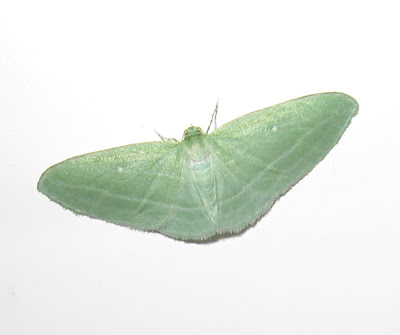Apt to be found nectaring at milkweed blossoms on sunny June days, the Banded Hairstreak (Satyrium calanus) is one of our most frequently encountered Lycaenid species.
The following image of a Banded Hairstreak caught my eye as I was reviewing the files on my hard drive. Individual Banded Hairstreaks can certainly vary in appearance but this seemed like a rather extreme departure from the norm. After doing a bit more reading and research, methinks this is the much less common Hickory Hairstreak (Satyrium caryaevorum).
A word of caution: relying on appearance alone to identify insects to the species level is undependable, and I could well be wrong ... the correct procedure is to capture a specimen and examine the genitalia. Having said that, here are the criteria for separating the Banded Hairstreak and Hickory Hairstreak at – Butterflies of Canada ... Hickory Hairstreak
A word of caution: relying on appearance alone to identify insects to the species level is undependable, and I could well be wrong ... the correct procedure is to capture a specimen and examine the genitalia. Having said that, here are the criteria for separating the Banded Hairstreak and Hickory Hairstreak at – Butterflies of Canada ... Hickory Hairstreak
At first glance the Striped Hairstreak (Satyrium liparops) can be mistaken for one of its cousins (including the Edwards' Hairstreak, I don't have a photo of this species so here's a link to Butterflies and Moths of North America). However, the bands on this small butterfly's wings are much more widely spaced, the blue spot on its hind wing is capped with orange, and – said hindwing sports two distinct tails.
Changing the subject from befuddling little gray butterflies to confounding small green moths ...
A Blackberry Looper (Chlorochlamys chloroleucaria) encountered in late May. The upper surfaces of the bluish-green wings appear granulated and they have a white fringe around their borders. This moth is a female; the male has bipectinate (comb-like toothed margins on both sides) antennae.
A Blackberry Looper (Chlorochlamys chloroleucaria) encountered in late May. The upper surfaces of the bluish-green wings appear granulated and they have a white fringe around their borders. This moth is a female; the male has bipectinate (comb-like toothed margins on both sides) antennae.
All four wings of the Showy Emerald (Dichorda iridaria) have discal dots, distinctly green-bordered white lines, and clean, sharp edges.
An anterior view of the Showy Emerald ... the top and front views rule out the possibilty that this is a Red-fronted Emerald (Nemoria rubrifrontaria) or a Red-bordered Emerald (Nemoria lixaria).
Since the considerably smaller hindwings are challenging to position when pinning this moth, collectors have dubbed it The Bad-Wing (Dyspteris abortivaria). Also note the rounded appearance of the wings, and the small white discal dots on the front wings.
So where, you might ask, is the dreaded "Carnivorous Caterpillar" mentioned in the title? Sorry to say, I don't (yet) have a picture of a creepy (not to mention deviant) caterpillar chowing down hapless, helpless little bugs.
The larva of the Harvester (Feniseca tarquinius) does have the unique distinction of being the only Canadian caterpillar that feeds on other insects, specifically Woolly Aphids. The roots of the name Lycaenidae lie in the Greek word for wolf, so at least in the case of this butterfly the family name is apropos, it is – in a manner of speaking – an "aphid wolf".
The larva of the Harvester (Feniseca tarquinius) does have the unique distinction of being the only Canadian caterpillar that feeds on other insects, specifically Woolly Aphids. The roots of the name Lycaenidae lie in the Greek word for wolf, so at least in the case of this butterfly the family name is apropos, it is – in a manner of speaking – an "aphid wolf".
I almost managed to overlook this huge – close to 90 mm in length – boldly marked caterpillar sitting on a Virginia Creeper. This is the last (fifth) instar larva of the Pandorus Sphinx (Eumorpha pandorus). In addition to Virginia Creeper this species of sphinx moth also feeds on the leaves of grapes.
Pandorus Sphinx caterpillars lose the typical sphinx moth caudal horn as they grow and molt. Is the prominent black, red and white nub that remains meant to be a target, directing a predator's attention away from the head (to the right) toward a non-vital area of the body?
Feeling threatened by my proximity the cautious caterpillar has not only withdrawn its vulnerable head into its own fashionable turtle-neck collar, it is blowing bubbles from its mouth ... is this a noxious fluid that deters predators?
The day after I encountered the Pandorus Sphinx caterpillar, I stumbled across a Waved Sphinx (Ceratomia undulosa) larva near the same tree. I'm not using "stumbled across" as a figure of speech ... the insect was crawling on the ground and I almost stepped on it.
The caudal horn – a sphinx moth caterpillar trademark.
Judging by its size this is also probably a fifth instar caterpillar and ready to pupate any time; it measured a good 100 mm in length and easily spanned the palm of my hand. The preferred host plant of the Waved Sphinx is ash, but they will also eat oak, hawthorn and lilac.




















